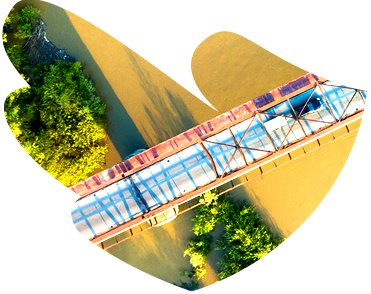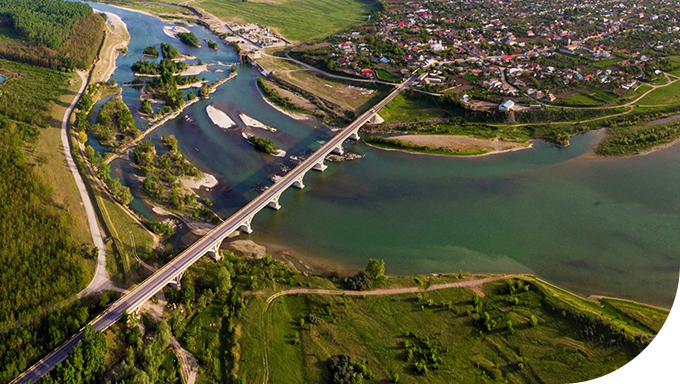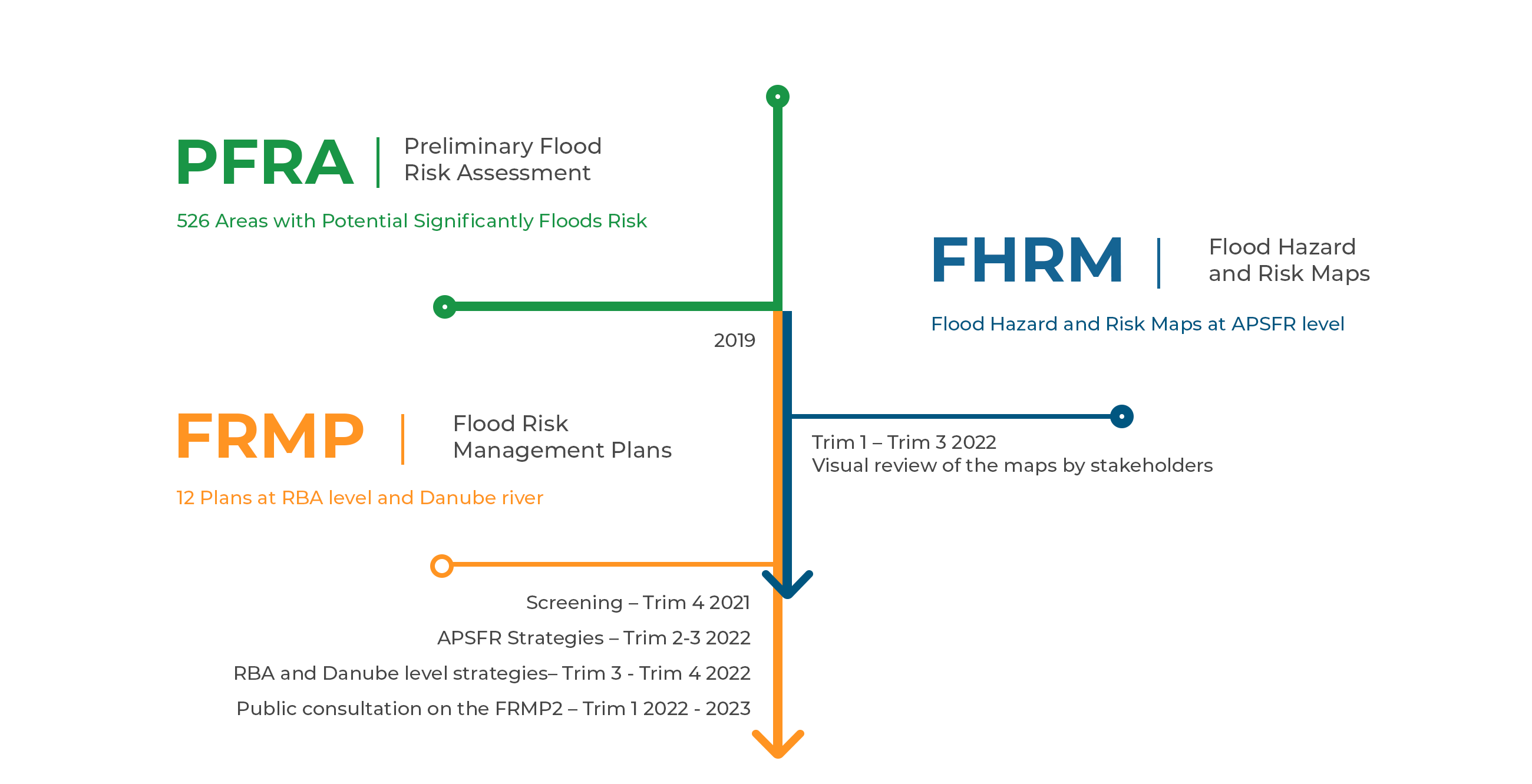Implementation of the Floods Directive Cycle 2
The EU Floods Directive requires the revision, every 6 years, of all stages of its implementation, from the preliminary assessment to flood risk management plans.



Romania successfully implemented the first cycle of the Floods Directive in 2016.
Since 2018, we are currently in the second implementation cycle of the Floods Directive. The first stage, for revision of the preliminary flood risk assessment, was already completed and reported to the European Commission in September 2019.
Authorities are now revising and developing stage 2, the Flood Hazard and Risk Maps, but also stage 3 – Flood Risk Management Plans. This revision is based on the lessons learned and on the evaluation of the 1st cycle, while following the best practices used across the EU. The revision purpose is to develop new enhanced measures for the flood risk management.
The Preliminary Flood Risk Assessment
During the 2nd implementation Cycle, the methodology for setting forth the areas of potential significant flood risk (APSFRs) has undergone a number of improvements, considering the following general principles:
- The evaluation of significant historical events shows that the area is prone, also for the time being, to the flood risk
- The potential flood risk assessment shows that the area is deemed to have a national strategic importance or critical in case of major emergency situations (such as damages to hospitals, international airports, schools, transportation infrastructure etc.);
- Flood risk management specialists at the level of River Basin Administrations or of other stakeholders at local level can clearly indicate areas prone to severe flood risk.
The process of reviewing the preliminary flood risk assessment from cycle 2 has involved the flood categorization depending on the flooding system: pluvial, fluvial overflows, torrents, dike breaches and coastal. Thus, a total of 526 APSFRs have been identified. They are divided into 506 APSFR for fluvial flood risk, 3 coastal and 17 APSFRs from pluvial (rain) sources.
Out of these 526 APSFRs, 343 have been identified as a priority for new modeling under the second cycle of the Directive, of which 191 for fluvial floods, 41 for flash floods, 69 for dike breaches, 3 for coastal floods and 17 pluvial APSFRs in urban areas. For the remaining 183 APSFRs, there are hazard maps available from the first cycle.
Updating the Hazard and Risk Maps
The second stage for implementing the second cycle of the Floods Directive consists in updating flood hazard and risk maps.
Maps will be posted on a geographic information system (GIS) platform and will have a friendly interface in order to enable all stakeholders, including citizens, to find their own location on the maps and to understand whether they are in one of the areas of potential significant flood risk (APSFR) and if so, what could be the water extent and depth in the respective area.
Users could identify for a specific APSFR what might be the damages caused to buildings, environment, cultural heritage, economic activity and population.
Maps will be jointly developed by a group of specialists from the Romanian Authorities and international consultants and will undergo a process of public consultation with stakeholders across APSFRs.
Final versions of the updated maps are expected by the end of 2022.

Flood Risk Management Plans
The third stage for implementing the 2nd cycle of the Floods Directive is the updating of the 12 flood risk management plans, one for each of the 11 River Basin Administrations and one for the Danube River.
The core of plans will be the new strategies and measures developed at the level of APSFRs and grouped in Programs of Measures.
At national level, there will be a program of measures mainly consisting in non-structural measures, such as legislative amendments and knowledge building for the specialists within Romanian Authorities. Non-structural measures have a wide national applicability and will be further developed and implemented by national authorities.
Structural measures, both „grey” ones, such as building or consolidation of dikes and dams, either management works for water courses, as well as the „green” ones, such as floodplain restoration and afforestation, will be detailed at the level of APSFRs in the program of measures specific for each of the 12 FRMPs.

Stakeholder involvement
Flood risks are not evenly distributed across the Romanian territory. However, the flood risk management requires the involvement of a large number of organizations, authorities and even of all citizens. As the risk mitigation measures in a certain area may be adopted in places located outside the respective area, but also because a flood caused by heavy rains might occur unexpectedly, it is necessary to inform all citizens of the flood risk and of the measures that each of us could take in order to be prepared.
Implementation of the 2nd cycle of the Floods Directive is achieved by stakeholder involvement, in three steps: information, engagement and consultation.
The information activity will be performed at national level. All Romanian citizens should be informed on the flood risk, on what measures can be adopted and on how they should act in case of flooding. The information activity will be carried out through both online and offline campaigns, via traditional media channels.
In the development of hazard and risk maps, as well as of programs of measures relevant parties will be engaged, such as local authorities, NGOs, representatives of the private sector and of the civil society, the academic environment, as well as leaders of vulnerable or marginalized communities.
The stakeholder engagement will mainly be achieved at river basin level during meetings for selection and debriefing the measures proposed by specialists. River Basin Administrations, with the support of the „Romanian Waters” National Administration and of the Ministry of Environment, Waters and Forests, will contact and invite the relevant stakeholders and will coordinate the stakeholder engagement process during working sessions.
Ultimately, after the programs of measures are addressed and the 12 FRMPs are prepared in draft, there will be a period of public consultation during which any Romanian citizen will have the opportunity to examine them and to provide comments or suggestions.
The stakeholder engagement relies on a dialogue and on the availability of everyone to take on this important role.
Soon a calendar of information and public consultation activities will be posted.
Stakeholder Information
2021 – 2023
The information activity will be carried out on an ongoing basis via this website and via social medial channels, as well as offline, by press releases and printed materials.
Stakeholder Engagement
2021 – 2022
The engagement will mainly be achieved at regional level by meetings organized by RBAs, as well as at national level, by structures such as the Technical Advisory Group (TAG) and the Technical Working Group (TWG) on specific topics.
Stakeholder
Consultation
2022 – 2023
The public consultation on the FRMPs will take place for a period of 6 months, when the draft plans will be ready. They are expected by the end of 2022.
 Weather Warnings
Weather Warnings
